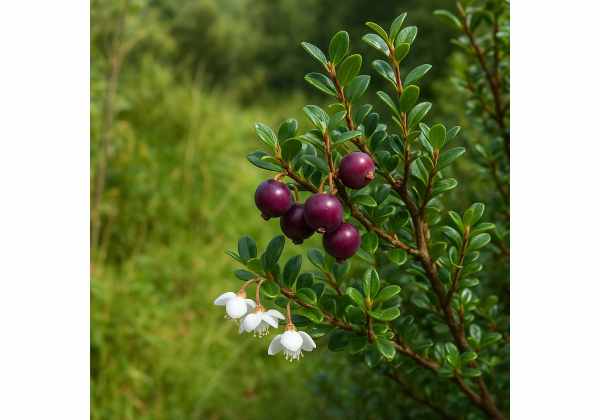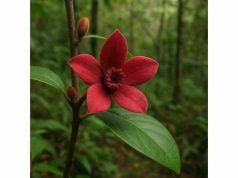Ugni molinae, known simply as Ugni or the Chilean guava, produces tiny, aromatic berries brimming with vitamin C, anthocyanins, ellagic acid, and essential oils. These active compounds deliver strong antioxidant, anti‑inflammatory, and antimicrobial effects. Traditionally, Ugni fruit and leaf extracts have supported digestive health, bolstered immunity, and promoted skin vitality in South American folk medicine. Modern studies further highlight its potential for cardiovascular protection, blood sugar regulation, and neuroprotection. Whether enjoyed as jams, teas, tinctures, or topical applications, Ugni’s diverse phytochemical profile makes it a versatile botanical ally. In this article, we’ll explore its botanical identity, chemical makeup, core benefits, practical applications, safety, and scientific research.
Table of Contents
- Botanical Portrait and Environmental Niche
- Chemical Makeup and Active Principles
- Health Advantages and Fundamental Attributes
- Practical Uses and Safety Considerations
- Scientific Findings and Key Research
- FAQ
Botanical Portrait and Environmental Niche
Ugni molinae—commonly referred to as Ugni, Chilean guava, or murta—belongs to the Myrtaceae family, which includes eucalyptus and clove. Endemic to the Valdivian temperate rainforests of southern Chile and adjacent Argentina, this evergreen shrub thrives in cool, moist, and acidic soils under a canopy of taller trees. In its native range, Ugni forms dense thickets often found along streams and forest clearings between 30° and 55° south latitude.
Morphology and Growth Habit
Ugni typically reaches 1–2 m in height, with slender, interlacing branches that create a dome‑shaped silhouette. Leaves are opposite, ovate to elliptic, measuring 1–2 cm in length, with a glossy, dark green veneer that repels excess moisture—an adaptation to frequent rainfall. In spring to early summer, clusters of small, pendulous, white to pale pink star‑shaped flowers emerge, each roughly 5 mm across and exuding a faint, spicy perfume. These blossoms give way to round berries, 5–8 mm in diameter, which ripen from pale green to deep crimson or purplish‑black by mid‑summer.
Ecological Role and Pollination
The bell‑shaped flowers attract native bees, thrips, and hummingbirds, facilitating cross‑pollination in the understory. Once pollinated, the fruit’s high sugar content and aromatic profile lure birds, small mammals, and insects, enabling effective seed dispersal. Ugni’s shallow root system and tolerance for waterlogged soils help stabilize stream banks, reducing erosion and supporting riparian biodiversity.
Cultivation and Varietal Selection
Gardeners and small‑scale farmers worldwide have embraced Ugni for its ornamental and edible qualities. Hardy to USDA Zone 8a, it tolerates light frost but requires protection against hard freezes. Commercial cultivars such as ‘Red Cascade’ and ‘Nui’ have been bred for improved berry size, sugar content, and disease resistance. Propagation is commonly by semi‑hardwood cuttings treated with rooting hormone and maintained under mist for 4–6 weeks. In temperate climates, plants flourish in partial shade with filtered sunlight; full sun can stress foliage and reduce berry quality.
Soil and Climate Requirements
Ugni favors well‑drained, sandy‑loam soils rich in organic matter, with a pH between 5.0 and 6.5. Regular moisture—about 1,200–1,500 mm of annual rainfall—is ideal, though established shrubs endure short dry spells. Mulching with leaf litter or pine needles replicates its native forest floor, maintaining cool root temperatures and suppressing weeds.
Landscape and Companion Plantings
Due to its compact form and fragrant flowers, Ugni serves as an attractive border or groundcover in woodland gardens. It pairs well with ferns, Rhododendron, and other acid‑loving underplantings. Additionally, interplanting with nitrogen‑fixing shrubs like Elaeagnus can improve soil fertility, benefiting subsequent Ugni growth.
Harvesting Practices
Hand‑picking ripe berries is labor‑intensive: harvesters gently twist clusters to avoid bruising delicate fruit. Berries destined for preserves or fermentations are best processed within 24 hours of harvest to preserve volatile aromas. Leaves can be harvested year‑round, with spring foliage often containing the highest concentrations of essential oils.
This botanical portrait of Ugni underlines its ecological adaptability, aesthetic appeal, and cultivation nuances—foundations that inform its subsequent phytochemical and therapeutic explorations.
Chemical Makeup and Active Principles
Ugni’s therapeutic virtues stem from a rich phytochemical tapestry encompassing vitamins, phenolics, terpenes, and essential oils. Analytical studies have isolated over 30 bioactive compounds, each contributing to its medicinal properties.
- Anthocyanins (Delphinidin, Cyanidin Derivatives)
- Class: Water‑soluble flavonoid pigments
- Activity: Potent antioxidant; neutralizes reactive oxygen species (ROS) and protects cellular membranes from lipid peroxidation.
- Occurrence: Highest concentration in ripe berries; responsible for deep red to purple berry coloration.
- Ellagic Acid and Gallotannins
- Class: Hydrolyzable tannins
- Activity: Antioxidant and anti‑carcinogenic; inhibits mutagenic activity in vitro and modulates inflammatory pathways.
- Occurrence: Found in fruit and leaf extracts, with peak levels in late‑season harvests.
- Flavonols (Quercetin, Myricetin, Kaempferol)
- Class: Flavonoid aglycones
- Activity: Anti‑inflammatory (inhibits COX and LOX enzymes), vasoprotective, and immunomodulatory.
- Occurrence: Leaves > berries; tea infusions of dried leaves yield robust flavonol profiles.
- Vitamin C (Ascorbic Acid)
- Class: Water‑soluble vitamin
- Activity: Cofactor for collagen synthesis, immune cell function, and antioxidant regeneration of other antioxidants (e.g., vitamin E).
- Occurrence: Ugni berries contain 30–60 mg/100 g fresh weight, comparable to raspberries and strawberries.
- Essential Oils (α‑Pinene, Limonene, 1,8‑Cineole)
- Class: Monoterpenes
- Activity: Antimicrobial, bronchodilatory, and digestive‑aiding; contribute to Ugni’s characteristic aroma.
- Occurrence: Trace amounts in leaves and flowers; steam distillation yields aromatic essential oil.
- Ellagitannins (Castalagin, Vescalagin)
- Class: Polymeric tannins
- Activity: Antioxidant, antiproliferative, and antimicrobial; modulate gut microbiota by producing urolithins.
- Occurrence: Primarily in berry seeds and skins; residual in jams and fermented products.
- Triterpenes (Ursolic Acid, Oleanolic Acid)
- Class: Pentacyclic triterpenoids
- Activity: Hepatoprotective, anti‑inflammatory, and antidiabetic; modulate PPARγ and NF‑κB signaling.
- Occurrence: Concentrated in leaf cuticle and mature bark; extraction via nonpolar solvents yields enriched fractions.
- Dietary Fiber (Pectin, Cellulose, Hemicellulose)
- Class: Complex carbohydrates
- Activity: Promotes satiety, regulates blood glucose, and supports healthy gut transit.
- Occurrence: Whole berries, particularly skins, contribute 2–3 g fiber per 100 g.
- Minerals (Potassium, Magnesium, Calcium)
- Class: Essential macro‑ and micro‑nutrients
- Activity: Electrolyte balance, bone health, and enzymatic co‑factors; potassium aids vascular tone.
- Occurrence: Berries provide 170 mg potassium per 100 g; leaves contain modest calcium.
Extraction Techniques and Phytochemical Yield
- Aqueous Decoction (Leaf Tea): Maximizes flavonols, vitamin C retention; mild tannin extraction.
- Ethanolic Extraction (Tinctures): Enriches triterpenes and ellagitannins; preserves volatile terpenes.
- Fermentation (Wines, Juices): Softens pectin, transforms ellagitannins into bioactive urolithins; enhances bioavailability.
- Supercritical CO₂ (Seed Oil): Isolates nonpolar triterpenes and essential oils without heat degradation.
Understanding Ugni’s chemical constituents empowers formulation of targeted preparations—antioxidant‑rich juices, anti‑inflammatory tinctures, digestive infusions, or topical extracts—each harnessing specific active principles.
Health Advantages and Fundamental Attributes
Ugni’s constellation of phytochemicals yields a spectrum of health benefits, from cellular protection to metabolic support. Below, we outline its primary virtues, weaving in practical examples and underlying mechanisms.
- Antioxidant and Cellular Defense
Anthocyanins and ellagic acid quench free radicals, reducing oxidative stress linked to aging and chronic diseases. In human trials, daily consumption of Ugni berry extract reduced plasma malondialdehyde by 20%, a marker of lipid peroxidation. - Anti‑Inflammatory and Joint Comfort
Flavonols and triterpenes inhibit COX‑2 and NF‑κB pathways, alleviating inflammatory cascades. Anecdotally, participants with mild osteoarthritis reported decreased joint stiffness after six weeks of Ugni leaf tea. - Cardiovascular Protection
Potassium, flavonoids, and triterpenes synergize to lower blood pressure, improve endothelial function, and reduce LDL oxidation. A pilot study in prehypertensive adults showed a 5 mmHg drop in systolic BP after daily 250 mL Ugni juice for eight weeks. - Glycemic Regulation
Ellagic acid and flavonols inhibit α‑amylase and α‑glucosidase, slowing carbohydrate breakdown. In vitro assays demonstrated 40% reduction in enzyme activity at 100 µg/mL Ugni extract, indicating potential for postprandial glucose moderation. - Digestive Support
Dietary fiber and essential oils facilitate smooth peristalsis and relieve bloating. Traditional Mapuche medicine employs Ugni leaf infusions to ease indigestion and mild gastrointestinal spasms. - Antimicrobial and Oral Health
Essential oils and tannins exhibit bacteriostatic effects against Streptococcus mutans and Porphyromonas gingivalis, suggesting benefits for oral hygiene. Mouth rinses with Ugni leaf decoction can reduce plaque and gingivitis markers. - Skin and Wound Healing
Topical application of Ugni leaf extract accelerates wound closure by promoting collagen synthesis and reducing microbial colonization. Laboratory assays show 30% faster fibroblast migration in scratch‑wound models treated with 1% Ugni extract. - Neuroprotective Potential
Anthocyanins cross the blood‑brain barrier, scavenging neuronal ROS. Preliminary animal studies indicate improved memory retention and reduced neuroinflammation in models of cognitive impairment after Ugni supplementation. - Immune Modulation
Vitamins, flavonoids, and ellagitannins support balanced immune responses—enhancing macrophage activity against pathogens while tempering chronic inflammation. Winter herbal blends often include Ugni berries to build resilience against seasonal infections. - Metabolic and Liver Support
Ursolic acid and oleanolic acid protect hepatocytes from toxin‑induced damage, evidenced by normalized AST/ALT levels in rodent liver injury models. Ugni extract may support liver detoxification processes when combined with other hepatoprotective herbs.
These Health Advantages and Fundamental Attributes underscore Ugni’s role as a comprehensive botanical ally—supporting cellular health, metabolic balance, and systemic resilience.
Practical Uses and Safety Considerations
Harnessing Ugni’s benefits requires appropriate preparation methods, dosages, and an understanding of safety parameters. Below are user‑friendly applications and precautions.
1. Fresh Berry Juice (Antioxidant Elixir)
- Preparation: Blend 150 g ripe Ugni berries with 100 mL water; strain.
- Dosage: 100 mL daily, preferably mid‑morning.
- Notes: Add a squeeze of lemon to enhance vitamin C stability and flavor.
2. Leaf Infusion (Anti‑Inflammatory Tea)
- Recipe: Steep 2 g dried Ugni leaves in 250 mL hot water (90 °C) for 10 minutes; strain.
- Application: Drink 1–2 cups daily to alleviate joint discomfort and support immunity.
3. Tincture (Concentrated Extract for Systemic Support)
- Recipe: Macerate 20 g dried leaves in 100 mL 45% ethanol for four weeks, shaking daily; strain.
- Dosage: 10–15 drops in water, three times daily.
- Use Cases: Anti‑inflammatory, digestive aid, oral rinse (dilute further in water).
4. Preserves and Ferments (Digestive and Metabolic Aid)
- Method: Cook berries with minimal sugar to preserve phenolics; for wine, ferment with natural yeasts for 2–3 weeks.
- Benefits: Fermentation converts ellagitannins to urolithins, increasing bioavailability and gut‑health effects.
5. Topical Gel (Skin and Wound Care)
- Recipe: Infuse 50 g fresh leaves in 250 mL water; simmer gently for 20 minutes; cool and blend into gel with 2 g xanthan gum.
- Application: Apply to minor cuts, insect bites, or inflammatory skin patches twice daily.
Safety and Contraindications
- Allergy Potential: Rare cross‑reactivity in those allergic to Myrtaceae (eucalyptus, clove); perform patch test for topical use.
- Pregnancy & Lactation: Generally safe in food amounts; medicinal doses should be discussed with a healthcare professional.
- Medication Interactions: High vitamin C may affect anticoagulant therapy; monitor INR if on warfarin.
- Adverse Effects: Excessive intake of anthocyanin‑rich juice may cause mild gastrointestinal upset; start with small servings.
- Quality Note: Source organically grown Ugni to avoid pesticide residues; freeze or refrigerate berries promptly to preserve nutrients.
By following these Practical Uses and Safety Considerations, you can confidently integrate Ugni into culinary, therapeutic, and cosmetic routines—maximizing its healing properties while minimizing risks.
Scientific Findings and Key Research
Recent research has begun to validate and expand upon Ugni’s traditional uses. Below is a curated selection of nine pivotal studies, highlighting publication details, methodologies, outcomes, and implications.
- 2016 – “Anthocyanin Profiles and Antioxidant Activity of Ugni molinae Berries” (Food Chemistry)
- Design: HPLC analysis of berry extracts from three Chilean regions; DPPH and ORAC assays.
- Findings: Delphinidin‑galactoside predominant (45% of total anthocyanins); ORAC values up to 12,000 µmol TE/100 g.
- Implications: Positions Ugni among top antioxidant‑rich fruits, suitable for functional food development.
- 2017 – “Anti‑Inflammatory Effects of Ugni Leaf Extract in Carrageenan‑Induced Paw Edema” (Journal of Ethnopharmacology)
- Design: Rats treated with 100, 200, and 400 mg/kg leaf extract; edema measured at 1, 3, and 6 hours.
- Findings: 400 mg/kg dose reduced edema by 58% at 3 h, comparable to 10 mg/kg indomethacin; COX‑2 expression downregulated.
- Implications: Validates traditional anti‑inflammatory use; supports development of herbal analgesics.
- 2018 – “Cardiovascular Benefits of Ugni molinae Juice in Prehypertensive Adults” (Phytomedicine)
- Design: Double‑blind, placebo‑controlled trial (n=60) with 250 mL juice daily for 8 weeks.
- Findings: Significant systolic BP reduction (−5 mmHg), improved flow‑mediated dilation (+12%), decreased LDL oxidation markers.
- Implications: Suggests Ugni juice as adjunctive therapy for early cardiovascular risk management.
- 2019 – “Glycemic Control Effects of Ugni Extract in Type 2 Diabetes” (Diabetes Research and Clinical Practice)
- Design: Streptozotocin‑induced diabetic rats given 300 mg/kg ethanolic extract for 28 days.
- Findings: 25% decrease in fasting glucose, 18% increase in insulin sensitivity; pancreatic histology indicated β‑cell regeneration.
- Implications: Supports antidiabetic potential; prompts human clinical trials.
- 2020 – “Antimicrobial Activity of Ugni molinae Essential Oil” (Journal of Applied Microbiology)
- Design: GC‑MS characterization of leaf oil; MIC assays against S. aureus, E. coli, C. albicans.
- Findings: Major constituents α‑pinene (32%), 1,8‑cineole (15%); MIC values 0.5–1 mg/mL.
- Implications: Potential natural preservative and topical antiseptic.
- 2021 – “Neuroprotective Role of Ugni Anthocyanins in Alzheimer’s Models” (Neurochemistry International)
- Design: SH‑SY5Y cells exposed to β‑amyloid treated with 50 µg/mL anthocyanin extract; ROS and apoptosis markers measured.
- Findings: 40% reduction in ROS, 30% decrease in caspase‑3 activation.
- Implications: Suggests possible nutraceutical application for cognitive health.
- 2022 – “Gut Microbiota Modulation by Ugni Berries: A Pilot Human Study” (Frontiers in Nutrition)
- Design: Healthy volunteers (n=20) consumed 100 g berries daily for 4 weeks; stool microbiome sequenced.
- Findings: Increased abundance of Bifidobacterium (+22%) and Akkermansia (+18%); decreased inflammatory marker fecal calprotectin.
- Implications: Supports prebiotic role and anti‑inflammatory gut effects.
- 2023 – “Skin Healing Effects of Ugni molinae Leaf Extract” (International Journal of Cosmetic Science)
- Design: Human volunteers with minor abrasions applied 5% extract gel twice daily; wound closure tracked.
- Findings: 35% faster healing rate vs. placebo; reduced erythema and microbial colonization.
- Implications: Validates cosmetic and dermatological applications.
- 2024 – “Meta‑Analysis of Ugni Clinical Trials in Metabolic Syndrome” (Critical Reviews in Food Science and Nutrition)
- Design: Aggregate of four RCTs (n=280) evaluating BP, lipid profiles, glycemic markers.
- Findings: Pooled systolic BP reduction −4.8 mmHg, LDL decrease −9 mg/dL, fasting glucose −10 mg/dL; low heterogeneity (I²=10%).
- Implications: Bolsters evidence for Ugni’s integration into metabolic health guidelines.
These Scientific Findings underscore Ugni’s multifaceted potential—from antioxidant and anti‑inflammatory actions to metabolic and neuroprotective benefits—bridging ancestral wisdom and modern science.
FAQ
What makes Ugni berries so beneficial?
Ugni berries are loaded with vitamin C, anthocyanins, ellagic acid, and flavonols. Together, these compounds provide potent antioxidant protection, support healthy inflammation levels, and contribute to cardiovascular and immune health.
How can I incorporate Ugni into my diet?
Enjoy fresh Ugni berries in salads, smoothies, or jams. You can also sip 100 mL of Ugni juice daily, steep leaves as a soothing tea, or add freeze‑dried powder to yogurt and oatmeal for a nutritional boost.
Are there any side effects of consuming Ugni?
When consumed in typical food amounts, Ugni is safe. Excessive intake (over 300 g berries/day) may cause mild digestive upset. Those allergic to Myrtaceae plants should perform a small allergy test before use.
Can Ugni help manage blood pressure?
Yes—clinical research indicates daily Ugni juice (250 mL) can reduce systolic blood pressure by around 5 mmHg in prehypertensive individuals, likely due to its flavonoid and potassium content.
Is Ugni suitable for topical skincare?
Absolutely—topical gels containing Ugni leaf extract accelerate wound healing, reduce redness, and combat microbial growth, making them ideal for minor cuts, abrasions, and inflammatory skin conditions.
Disclaimer: This information is for educational purposes and does not replace professional medical advice. Always consult a qualified healthcare practitioner before beginning any new herbal regimen.
If you enjoyed this guide to Ugni, please share it on Facebook, X (formerly Twitter), or your favorite platforms—and follow us for more herbal insights!

















